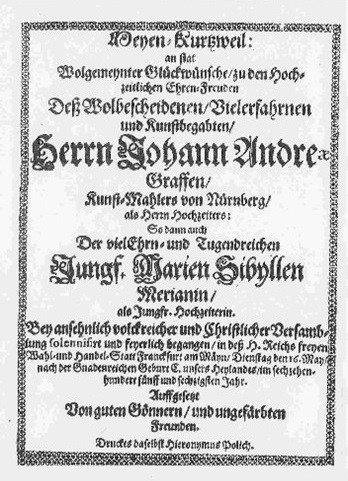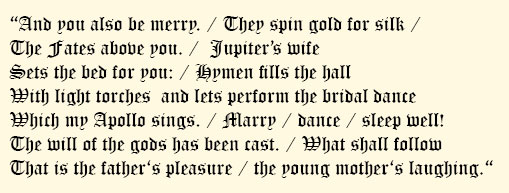POEMS BY SEVERAL AUTHORS
May Amusement
instead of
well-meant Congratulations /
on the Occasion of the Wedding
Joys honouring the modest / much experienced
and talented Artist
Mr Johann Andreae
Graff/
Art-Painter from Nuremberg /
as Master Bridegroom
So then also
The very honourable and virtuous
Maiden Maria Sibyl
Merian /
as Virgin Bride.
At a respectably numerous and Christian Gathering
and solemnly celebrated / in the Holy Roman Empire's
Free, Electoral and Trade City of Frankfurt am Main /
Tuesday, 16th of May / after the gracious Birth of C[hrist].
Our Saviour / in the sixteen hundred and sixty-fifth Year.
Composed
By good Patrons / and uncoloured (= true, honest)
Friends.
Printed there by Hieronymus Polich.
Transcription of the German Text
Meyen=Kurtzweil: an stat Wolgemeynter Glückwünsche / zu den Hoch- zeitlichen Ehren-Freuden Deß Wolbescheidenen / Vielerfahrnen und Kunstbegabten / Herrn Johann Andreae Graffen/Kunst-Mahlers von Nürnberg / als Herrn Hochzeiters:
So dann auch Der vielEhrn- und Tugendreichen Jungf. Marien Sibyllen Merianin / als Jungfr. Hochzeiterin.
Bey ansehnlich volckreicher und Christlicher Versamb- lung solennisirt und feyerlich begangen / in deß H. Reichs freyen Wahl- und Handel-Statt Franckfurt am Mäyn / Dienstag den 16. May / nach der Gnadenreichen Geburt C. unsers Heylandes / im sechzehen-hundert fünff und sechzigsten Jahr. Auffgesetzt Von guten Gönnern / und ungefärbten Freunden. Druckts daselbst Hieronymus Polich
Reference: Ratsschulbibliothek Zwickau,
Shelfmark: 48.8.7.(4); MF 5628
Up to now, only the title page has been digitised.
Explanations regarding the Title Page
(1) Probably not all authors could personally attend the wedding. For well-wishers from afar, written congratulations with such poems were a special token of affection, such as for the cousin and student in Heidelberg.
(2) The name "Merianin" (in German) shows that feminine endings on the surnames of girls and women were common at that time not only in Nuremberg but also in Frankfurt. However, they are not common in English and the "in" is therefore not included in the translation here.
(3) In the seventeenth century the expression "uncoloured", which is no longer in use today as a characterisation of people, meant that they were genuine, upright friends.
The Authors and their Poems
A "good patron" who only gives his initials "J. G. S." is the author of the first two poems. He pays tribute to spring and especially May as the most beautiful time for weddings and he praises love.
In his second poem, a "Dual Sonnet ", the conclusion reads:
Greek and Roman deities known at the time:
Fates = goddesses of fortune
Hymen = god of marriage
Jupiter's consort = goddess Juno
Apollo = god of spring, light, healing, prophecy and fine arts
The next author, Joh. David Heim(ius), was born in the same year 1647 as Maria Sibylla. He was not just a friend but also a cousin, a son of Merian’s mother's brother. In 1665, he was living as a "phil. stud." (student of philosophy) in Heidelberg and the way to the wedding celebration in Frankfurt was too far.
Instead, he sent two poems and greetings with a
His first poem is remarkable in form and content, for it is written entirely in Latin and in the first part humorously describes a fictitious scene in which Apollo finds he is missing one of his nine Muses while he is counting them. He sends Mercury on a search. The latter roams the whole world and the heavens, even the Underworld oceans, and arrives at the wedding celebration completely exhausted. Relieved, he sees the ninth Muse in the bride and offers her his congratulations.
Here - according to the preliminary evaluation of the text so far - Christ is invoked for the only time.
In the second part of the poem, Mercury embroiders his congratulations with many comparisons, portraying the union as almost endless happiness which in the end should lead directly to Heaven.
The author is aware that his poem is not easily understood and therefore asks the reader to read it three or four times:
With 14 (!) absurd images of impossible events, he evokes - here translated after 350 years - the duration of happiness, especially for the bride, which, for example, should only end:
In the final verse, he extends the temporal horizon to a grotto on the terrifying River Styx, border between this world and the hereafter.
Only when the shining red-tinged sky unites with the Stygian grotto and earth, sea and Underworld are confounded, shall the bride's earthly joys, which God sends without number from Heaven, also come to an end:
In another poem (in German), the author, in accordance with the nature-oriented spirit of the times, compares spring with love and wishes the bride:
These poems by "J. G. S." and J. D. Heim thus contain wishes which are applicable to many bridal couples and were perhaps also recited at other weddings. In contrast, Clos Achtzenheller, the last "uncoloured” (true, honest) friend in this booklet, addresses the bridal couple directly:
His recommendations for their artistic work are clear for both, thus also for the woman as painter in the seventeenth century (!):
All the five poems in this booklet give us an inkling of the general tone typical of that time with sophisticated, cheerful entertainment, which we can thus well imagine at the wedding celebration of Graff and Merian with the bride's mother, the foster father Marrell and their well-educated guests.
Interpretation: Margot Lölhöffel












